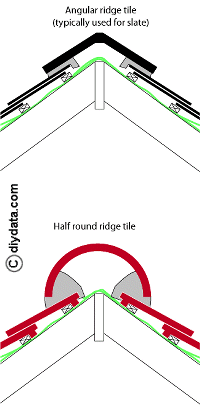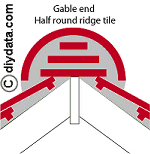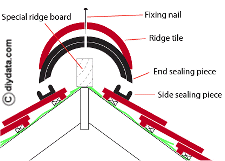Roofing - fixing ridge tiles
mortar bonded - fixing systems
Safety: Working on a roof involves working at height (even on a bungalow), so always use scaffolding or other stable platform, never use just ladders.
The ridges of slate and tiled roofs are normally covered by ridge tiles in the same or a contrasting colour. Two types are commonly used, half round or angular - angular ridge tiles are usually used for slate roofs.
Where different ridges meet, either two horizontal ridges or a horizontal ridge and hip ridges, the ridge tiles need to be cut so that there is a uniform gap of about 10mm between them which should be neatly pointed.
Traditionally ridge tiles are fixed using mortar to bond them to the tiles, most modern tile manufacturers produce 'systems' which mechanically secure the tiles to the roof without mortar - see below.
Mortar bonded ridge tiles
 The edge of the ridge tiles need to seal the top of the slates/ tiles by at least 75mm (3 inches), for slate and flat faced tiles this is achieved using a simple mortar bed (3:1 sharp sand:cement) along the edges of the ridge tiles/ slates. For tiles with a deep profile, the recesses are built up using small slips of flat tile bedded in mortar before applying the mortar bed for the ridge tile itself.
The edge of the ridge tiles need to seal the top of the slates/ tiles by at least 75mm (3 inches), for slate and flat faced tiles this is achieved using a simple mortar bed (3:1 sharp sand:cement) along the edges of the ridge tiles/ slates. For tiles with a deep profile, the recesses are built up using small slips of flat tile bedded in mortar before applying the mortar bed for the ridge tile itself.
Use a solid bed of mortar at the ends of ridge tiles to fill the gap where they met (see picture below), use a piece of flat tile slip (or slate) to bridge the gap between the tops of the slates/tiles on either side and to support the mortar which fills the gap underneath and between the ridge tiles.
Set the ridge tile onto the mortar beds and push it firmly down - remove any mortar which is squeezed out along the lower edges using a trowel and smooth the joint - take care not to smear the mortar on to the tiles. Ensure that the gap between the ends of each ridge tile is filled - smooth the mortar off at each joint as you work along the ridge.
The ridge tiles should be set in a line parallel with that of the roof ridge.
Hip and Gable ends
On hip roofs, the lowest ridge is cut so that the lower end aligns with the lower edge of the tiles/slates on the adjoining roof faces. A galvanised hip iron is normally secured to the roof timbers at the lower end under the mortar bed and the lowest tile is set just clear of this.
The ridge tiles used at gable and lower hip ends should be full length, so some forward planning needs to be given for any cutting required - i.e. fit the cut ridge tiles away from the ends.
Modern Standards and practice call for the 90cm (3 ft) of ridge tiles from gable ends to be mechanically secured to the roof ridge batten as well as being mortar bonded - one way is to use special ridge tiles which can be secured to the ridge board by means of a short length of galvanised wire, alternatively the ridge tiles may be drilled to provide a fixing point.
 The end of the half
round ridge tile may either be filled with mortar and pieces of tile or covered with a pre-made end cap.
The end of the half
round ridge tile may either be filled with mortar and pieces of tile or covered with a pre-made end cap.
Mechanical fixing systems
Most tile manufacturers produce mechanical fixing systems which do away with the use of mortar.
 A typical fixing system consists of:
A typical fixing system consists of:
- Side sealing pieces which are laid along the sides of the ridge and provide the seal between the roof tiles and the ridge tiles. Different seals are available to suit the profile of different roof tiles.
- End sealing pieces which straddle the ridge at the end of each ridge tile to seal the gap between adjacent tiles.
- A special ridge board mounted above the apex of the trusses to take the fixings for the ridge tiles. This ridge board needs to be carefully positioned so that it provides a space under the ridge tiles when they are fixed.
- Fixing nails (or screws) with seal washers, the nails are normally aluminium or other non corroding metal.
This is a typical system, each manufacturer has their own systems which are not interchangeable.
While these systems are fine for single ridges, they become complicated where two ridges met.
